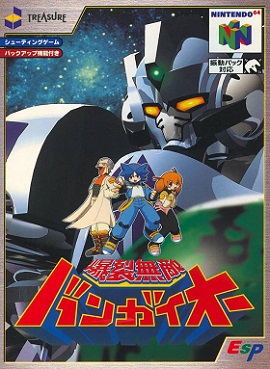
Bangai-O is a multidirectional shooter developed by Treasure and released in 1999 on the Nintendo 64 in Japan. It was ported to the Dreamcast worldwide shortly after with some gameplay changes and updated graphics and audio. The game places the player in control of a weaponized mech that can hover across large stages and fire at enemies all around them. The player must reach the end of each stage and defeat the boss, while avoiding hazards scattered across the map such as enemy mechs and gun turrets.

Metroid Prime Hunters is a 2006 action-adventure game developed by Nintendo Software Technology and published by Nintendo for the Nintendo DS. It was released in North America in March 2006, with other territories later. The story takes place in between the events of Metroid Prime and Metroid Prime 2: Echoes. Players assume the role of series protagonist Samus Aran, who investigates a mysterious message that originated from the Alimbic Cluster and comes into contact with a legion of bounty hunters.

Advance Wars: Dual Strike, known as Famicom Wars DS in Japan, is a turn-based strategy video game developed by Intelligent Systems and published by Nintendo for the Nintendo DS handheld game console. It is the third installment in the Advance Wars series and was released in 2005 for Japan on June 23, in North America on August 22, in Europe on September 30 and in Australia on March 22, 2006. The game is preceded by Advance Wars 2: Black Hole Rising and Advance Wars and succeeded by Advance Wars: Days of Ruin. Advance Wars is the international title of the Wars video game series, which dates back to the Family Computer game Famicom Wars in 1988.

Star Wars: Empire at War is a 2006 real-time strategy video game developed by Petroglyph Games and published by LucasArts for Microsoft Windows and Mac OS X. Set between Episode III and Episode IV, it focuses on the fledgling struggle between the Empire and the Rebels. It uses Petroglyph's game engine Alamo. In October 2006, an expansion titled Star Wars: Empire at War: Forces of Corruption was released. On May 31, 2014, online functionality, including network multiplayer and wireless chat, was discontinued after Glu Mobile's purchase of GameSpy and the subsequent shutdown of all game servers. As of September 1, 2017, the multiplayer has been re-enabled on the Steam version as well as workshop support being added.

Ogre Battle 64: Person of Lordly Caliber is a real-time tactical role-playing game developed by Quest Corporation and localized by Atlus USA for the Nintendo 64. Though conceptually similar to Ogre Battle: The March of the Black Queen, significant gameplay tweaks were implemented to change the game's overall flow. Ogre Battle 64 is the third game in the series, the first two being Ogre Battle: The March of the Black Queen, and Tactics Ogre. Gaidens have been released in Japan, on Game Boy Advance and Neo Geo Pocket Color. Unlike earlier Ogre Battle games, which feature Queen song titles, "Person of Lordly Caliber" is an original title. Ogre Battle 64 was released in PAL regions for the first time via the Wii Virtual Console in 2010.

WWF No Mercy is a professional wrestling video game released in 2000 by THQ for the Nintendo 64. It is based on the World Wrestling Federation and is named after the company's annual event of the same name. Developed by Asmik Ace Entertainment and AKI Corporation, No Mercy is the last in a series of Nintendo 64 wrestling games from the companies that started with WCW vs. nWo: World Tour.

Meteos is a 2005 tile-matching video game developed by Q Entertainment and published by Bandai for the Nintendo DS. It was produced by Q Entertainment founder Tetsuya Mizuguchi and designed by Masahiro Sakurai. Meteos was inspired by the video game Missile Command (1980), the film The Matrix (1999) and the television series 24 (2001-2010).

Star Wars Episode I: Racer is a 1999 racing video game based on the podracing sequence in the film Star Wars: Episode I – The Phantom Menace. The game features all of the racers and race course on Tatooine from The Phantom Menace. It adds several new courses, on Tatooine and various planets. It has several single player modes, including a tournament mode. The format of multiplayer mode varies by platform. Jake Lloyd and Lewis MacLeod, who portrayed Anakin Skywalker and Sebulba in The Phantom Menace, reprise their film roles in the game.
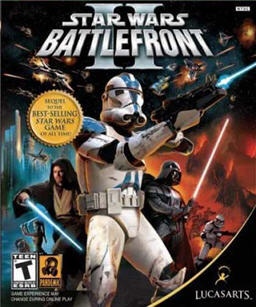
Star Wars: Battlefront II is a 2005 first-person shooter and third-person shooter video game based on the Star Wars film franchise. Developed by Pandemic Studios and published by LucasArts, it is a sequel to 2004's Star Wars: Battlefront and the second game in the Star Wars: Battlefront series. The game was released in PAL regions on October 28, 2005, on the PlayStation 2, PlayStation Portable (PSP), Microsoft Windows, and Xbox platforms, and in North America on November 1 of the same year. It was released on the PlayStation Store on October 20, 2009, for download on the PSP. The PSP version was developed by Savage Entertainment.

Fighting Force is a 1997 3D brawler developed by Core Design and published by Eidos. It was released for PlayStation, Microsoft Windows, and Nintendo 64 on 15 October 1997. Announced shortly after Core became a star developer through the critical and commercial success of Tomb Raider, Fighting Force was highly anticipated but met with mixed reviews.

Battalion Wars, released as Assault!! Famicom Wars in Japan, is a 2005 real-time tactics game developed by Kuju London and published by Nintendo for the GameCube. The player controls a vast array of units ranging from infantry, armoured divisions and aircraft, completing missions through a mixture of unit management and strategic planning. In the game's story, the player operates as a commander of a battalion, who initially take part in a conflict between two nations that culminates in an eventual alliance between them, in response to a surprise attack by a third nation.

Star Wars: Shadows of the Empire is a third-person shooter video game developed by LucasArts and published by Nintendo for the Nintendo 64 in 1996 and published by LucasArts for Windows in 1997. It is primarily a third-person shooter, with multiple types of vehicular combat sequences.

BattleTanx is a 1998 action game released for the Nintendo 64, produced by The 3DO Company. The game was followed by a 1999 sequel, titled BattleTanx: Global Assault.

WWF War Zone is a professional wrestling video game developed by Iguana West and released by Acclaim Entertainment in 1998 for the PlayStation, Nintendo 64, and Game Boy. The game features wrestlers from the World Wrestling Federation.
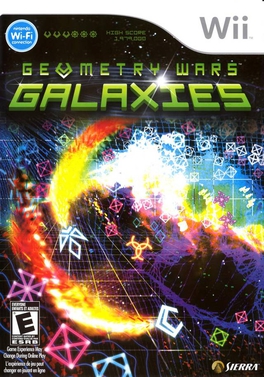
Geometry Wars: Galaxies is a multidirectional shooter video game developed by Bizarre Creations and Kuju Entertainment, and published by Vivendi Games for the Wii and Nintendo DS in 2007. As the first Geometry Wars game to be released on non-Microsoft platforms, Galaxies is a spin-off of Geometry Wars, which was originally included as a bonus game within Project Gotham Racing 2 on Microsoft's Xbox console. This updated version includes a single-player campaign mode, several multiplayer modes, Geometry Wars: Retro Evolved, and support for online leaderboards. The Wii version supports widescreen and 480p progressive scan display.
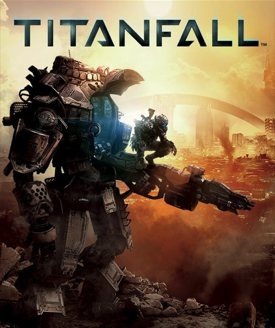
Titanfall is a multiplayer first-person shooter video game developed by Respawn Entertainment and published by Electronic Arts. It was released for Windows and Xbox One on March 11, 2014; an Xbox 360 version ported by Bluepoint Games was released April 8, 2014. The game was anticipated as the debut title from developers formerly behind the Call of Duty franchise.

Titanfall 2 is a first-person shooter video game, developed by Respawn Entertainment and published by Electronic Arts. A sequel to 2014's Titanfall, the game was released worldwide on October 28, 2016, for PlayStation 4, Windows, and Xbox One. In Titanfall 2, players control Titans, mecha-style exoskeletons and their pilots, who are agile and equipped with a variety of skills ranging from wall-running to cloaking. Set in a science fiction universe, the single-player campaign follows the story of Jack Cooper, a rifleman from the Frontier Militia, who bonds with his mentor's Titan BT-7274 after his mentor is killed in action. Together, they embark on a quest to stop the Interstellar Manufacturing Corporation (IMC) from using a superweapon to destroy the Militia base on the planet Harmony.
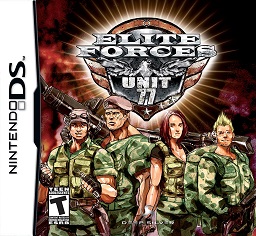
Elite Forces: Unit 77 is an action video game developed by Spanish studio Abylight and Gammick Entertainment for the Nintendo DS and DSiWare.

Command and Destroy is a real-time strategy video game developed by Cypron Studios and published by Destination Software Inc. and Zoo Digital Publishing for the Nintendo DS.
Titanfall is a media franchise that mainly features first-person shooter games. The series was created by Respawn Entertainment and debuted on Xbox and Microsoft Windows; it has expanded to other consoles and platforms.



















